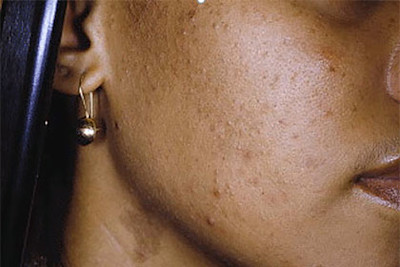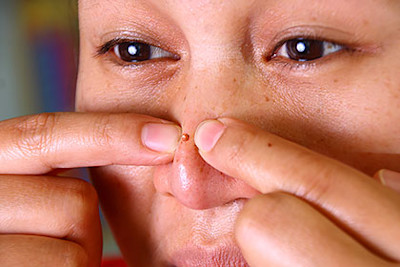10 tips for clearing acne in darker skin tones
How to treat acne in skin of color
For people with skin of color, acne is often accompanied by dark spots or patches called hyperpigmentation. Fortunately, there are plenty of things people with skin of color can do at home to help clear their acne, as well as the dark spots that linger afterwards.
The term “skin of color” refers to diverse skin types and complexions. It includes people of African, Asian, Latino, Mediterranean, Middle Eastern, and Native American descent.
People who have skin of color share some common skin-care concerns. Near the top of this list is how to get rid of acne and the dark spots that often appear when acne clears.
The secret to seeing clearer skin lies in knowing what really works (and what doesn’t) when it comes to treating darker skin types. Below you’ll find 10 tips that science shows can lead to clearer skin.
1. Treat both the acne and the dark spots.
Many people seek a dermatologist's help for the dark spots, which can last much longer than the acne. It's important to treat the acne, too. When you get rid of the acne, you eliminate what's causing the dark spots.
Acne and dark spots
Dermatologists recommend treating acne and dark spots at the same time.

2. Prevent dark spots and scars by treating acne early.
Studies show that treating acne when it's just beginning can prevent acne from getting worse. If acne worsens, becoming moderate to severe before treatment begins, people with skin of color have a higher risk of developing:
Spots and patches of darker skin
Keloids, a type of raised scar
3. Use acne products that work well in skin of color.
Not every acne product works well in skin of color. If you’re looking for products to treat mild acne, dermatologists recommend using products that contain one or more of the following ingredients.
A retinoid and benzoyl peroxide: This means buying two different products, but this combination works well in skin of color. The retinoid helps to unclog pores and reduce inflammation. It can clear pimples, blackheads, and whiteheads. A retinoid can also prevent new breakouts.
Benzoyl peroxoide can remove the bacteria that cause acne. If you're worried about it causing light spots on your skin, don't be. That’s a myth. It won't. However, it will bleach clothing, sheets, pillow cases, and towels.
To prevent benzoyl peroxide from irritating your skin, start with a product that contains 2.5% benzoyl peroxide. Products that contain more can cause dryness and flaking, which can worsen acne. If the 2.5% product irritates your skin, try using it every other day.
Do not pop pimples
If you pick, pop, or squeeze acne, you increase your risk of getting a scar.

Salicylic acid: This active ingredient helps unclog pores and prevent new acne breakouts.
Retinol: This can unclog pores and fade dark spots.
You’ll find benzoyl peroxide, salicylic acid, or retinol in acne products that you can buy without a prescription.
Retinol is a type of retinoid. Another retinoid that may be helpful is adapalene gel 0.1%. The U.S. Food and Drug Administration (FDA) has approved it (brand name Differin gel), for sale without a prescription.
4. Make some changes if acne only appears on your forehead and temples.
If acne only appears in these areas, your hair oil may be the cause. This is so common that there's actually a name for it—pomade acne.
You may be able to clear this acne by making some changes. Options that dermatologists recommend to their acne patients include:
Switch hair care products, using one that contains water or glycerin instead of oil.
Use the hair oil only in the middle of your scalp and ends of your hair.
If you continue to get breakouts, another option is to stop using these hair care products.
5. Use skin care products that won't clog your pores.
Like hair oil, your skin-care products could be causing your breakouts. If you apply a product that contains oil such as cocoa butter or shea butter to your face, back, or chest, it can clog your pores. Clogged pores can lead to acne.
To prevent skin care products from causing acne, use only products that are labeled “non-comedogenic” or “won’t clog pores.”
Cocoa butter
There’s absolutely no scientific evidence that cocoa butter can even out your skin tone, but it can cause acne.
6. Stop using heavy, oily makeups to cover dark marks.
While many women find this an effective way to hide blemishes, they often don’t realize that it’s also causing new blemishes.
It’s okay to wear makeup if you choose mineral makeup or one that says “non-comedogenic.” Mineral makeup can do a great job of hiding dark spots.
7. Be gentle with your skin.
Do you scrub your face to help get rid of acne blemishes? Are you convinced that popping a pimple or using strong soaps will lead to clearer skin? Hard as it is to believe, the truth is these things actually worsen acne.
Science shows that what really works to clear acne is gentle skin care. When caring for skin with breakouts, you want to:
Use a mild cleanser that won't clog your pores. (The label may say "won't clog pores" or "non-comedogenic.")
Apply the cleanser gently with your fingertips, and use only your fingertips to wash and rinse your face.
Gently pat your skin dry with a clean towel.
8. Wash caps and hats frequently.
Wearing a baseball cap or anything else on your head without washing (or dry cleaning) it allows sweat, dirt, and oil to accumulate. This can cause acne to flare.
9. See a dermatologist before using any type of chemical peel, microdermabrasion, or laser therapy to treat your acne.
If you have darkly pigmented skin, even the at-home versions of these acne treatments can cause side effects like permanent dark marks and light spots.
In the right hands, however, these treatments can be effective for treating acne in skin of color.
If you’re thinking about one of these treatments, you should see a doctor who specializes in treating the skin, such as a dermatologist. The dermatologist should frequently use this treatment in people who have skin of color. Be sure to ask how many people with skin of color the doctor has treated.
10. Seek a dermatologist’s help.
With a dermatologist’s help, virtually every case of acne and most dark spots can be successfully treated. Some people need prescription-strength medicine. Others need a specific combination of treatments. A dermatologist can examine your skin and create a treatment plan tailored to your needs.
What are you waiting for? Try one of these tips today. After all, the science shows these really work.
Related AAD resources
Images
Image 1: Used with permission of Journal of the American Academy of Dermatology. J Am Acad Dermatol. 2002;46(2):S103.
Image 2: Getty Images
References
Alexis AF. “Acne vulgaris in skin of color: Understanding nuances and optimizing treatment outcomes.” J Drugs Dermatol. 2014;13(6):s61-5.
Callender VD, Alexis AF, et al. “Racial differences in clinical characteristics, perceptions and behaviors, and psychosocial impact of adult female acne. J Clin Aesthet Dermatol. 2014;7(7):19-31.
Silverberg NB. “A brief primer on acne therapy for adolescents with skin of color.” Cutis. 2013;92(1):20-6.
Taylor SC and Summers P. “Acne” In Kelly AP, Taylor SC, et al. Dermatology for Skin of Color. The McGraw Hill Companies, China, 2009. 269-74.
Taylor SC, Cook-Bolden F, “Acne in skin of color.” J Am Acad Dermatol. 2002;46(2 Suppl Understanding):S98-106.
U.S. Food and Drug Administration. “FDA approves Differin Gel 0.1% for over-the-counter use to treat acne.” FDA news release issued July 8, 2016. Last accessed September 28, 2016.
 Atopic dermatitis: More FDA-approved treatments
Atopic dermatitis: More FDA-approved treatments
 Biosimilars: 14 FAQs
Biosimilars: 14 FAQs
 How to trim your nails
How to trim your nails
 Relieve uncontrollably itchy skin
Relieve uncontrollably itchy skin
 Fade dark spots
Fade dark spots
 Untreatable razor bumps or acne?
Untreatable razor bumps or acne?
 Tattoo removal
Tattoo removal
 Scar treatment
Scar treatment
 Free materials to help raise skin cancer awareness
Free materials to help raise skin cancer awareness
 Dermatologist-approved lesson plans, activities you can use
Dermatologist-approved lesson plans, activities you can use
 Find a Dermatologist
Find a Dermatologist
 What is a dermatologist?
What is a dermatologist?